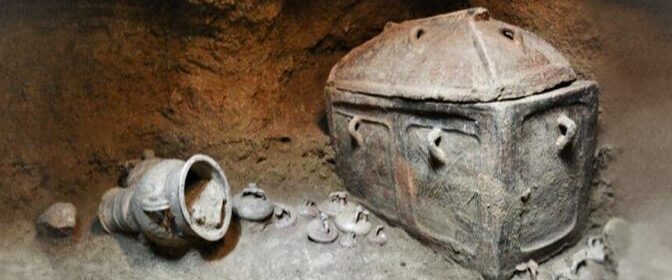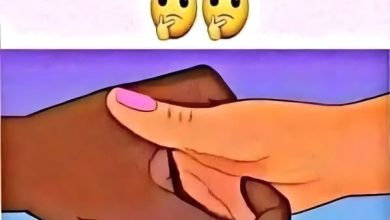Uncategorized
Greek Farmer Stumbles Onto 3,400-Year-Old Tomb Hidden Below His Olive Grove

Unbeknownst to a Greek farmer, a 3,400-year-old tomb containing two coffins and dozens of artefacts dating back to the Late Minoan era had been lying beneath his olive grove in southeast Crete.

The hole in the ground led to a Minoan Bronze Age tomb.
Both were buried in large vases – intricately embossed clay coffins that were common in Minoan culture in the Bronze Age – and they were surrounded by colourful funeral vases that indicatety under a shaded olive grove when the ground gave way, forcing him to find a new parking spot.

When he started driving off, the unidentified local noticed a four-foot-wide hole that had formed in the patch of land he had just vacated. Perched on the edge of the gaping space the man realized that “a wonderful thing” had been unintentionally unearthed.
The ancient chamber tomb was entirely intact and undamaged by looters.
Archaeologists from the local heritage ministry Lassithi Ephorate of Antiquities, have launched excavations under the olive grove of the farmer at Rousses, a small village just northeast of Kentri, Ierapetra, in southeastern Crete, according to a statement

The skeletal remains were found inside two larnakes (singular: “larnax”) – a type of small closed coffin used in the Minoan and Greek Bronze Age.
They identified the Minoan tomb, nearly perfectly preserved despite its advanced age, in a pit measuring roughly four feet across and eight feet deep. Space’s interior was divided into three carved niches accessible by a vertical trench.
In the northernmost niche, archaeologists found a coffin and an array of vessels scattered across the ground. The southernmost niche yielded a second sealed coffin, as well as 14 ritual Greek jars called amphorae and a bowl.
Two Minoan men were buried in the Crete tomb roughly 3,400 years ago (Lassithi Ephorate of Antiquities)Forbes’ Kristina Kilgrove writes that the high quality of the pottery left in the tomb indicates the individuals buried were relatively affluent. She notes, however, that other burial sites dating to the same Late Minoan period feature more elaborate beehive-style tombs.
“These [men] could be wealthy,” Kilgrove states, “but not the wealthiest.”
The ornate pottery vessels found inside the tomb were all in good condition.

Unlike many ancient tombs, the Kentri grave was never discovered by thieves, Argyris Pantazis, deputy mayor of Local Communities, Agrarian and Tourism of Ierapetra, tells local news outlet Cretapost.
In fact, the site likely would have remained sealed in perpetuity if not for the chance intervention of a broken irrigation pipe, which watered down the soil surrounding the farmer’s olive grove and led to his unexpected parking debacle.
“We are particularly pleased with this great archaeological discovery as it is expected to further enhance our culture and history,” Pantazis added in his interview with Cretapost. “Indeed, this is also a response to all those who doubt that there were Minoans in Ierapetra.”
According to Archaeology News Network, most Minoan settlements found on Crete are located in the lowlands and plains rather than the mountainous regions of Ierapetra.
Still, a 2012 excavation in Anatoli, Ierapetra, revealed a Minoan mansion dating to between 1600 and 1400 B.C., roughly the same time period as the Kentri tomb.
This latest find offers further proof of the ancient civilization’s presence—as Mark Cartwright notes for Ancient History Encyclopedia, the Minoans are most renowned for their labyrinthine palace complexes, which likely inspired the classic Greek myth of Theseus and the Minotaur. According to legend, Queen Pasiphae of Crete gave birth to the Minotaur, a fierce half-man, half-bull hybrid, after falling for a bull sent to Earth by the Greek god Zeus.

Minoan fresco is commonly known as the ‘Prince of the Lilies.’
The Minotaur, doomed to an eternity spent wandering the halls of an underground labyrinth and killing anyone it encountered, was eventually defeated by the demigod Theseus, who relied on an enchanted ball of thread provided by the king’s daughter, Ariadne, to escape the maze.
Much of the Minoans’ history remains unclear, but Forbes’ Kilgrove reports that natural disasters, including the eruption of the Thera volcano, an earthquake and a tsunami, contributed to the group’s downfall, enabling enemies such as the Mycenaeans to easily invade. Analysis of the excavated Kentri tomb may offer further insights on the Minoan-Mycenaean rivalry, as well as the Cretan civilization’s eventual demise.




